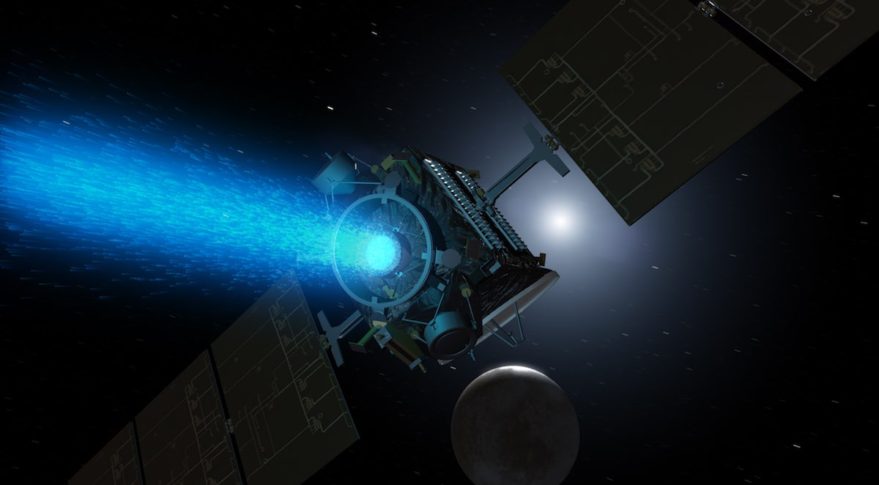NASA Reviews Options for Dawn Extended Mission

WASHINGTON — NASA expects to make a decision within the next two months whether to keep the Dawn spacecraft in orbit around the largest body in the main asteroid belt or have it fly past another asteroid.
Dawn completed a one-year extended mission in orbit around Ceres at the end of June, but NASA did not announce whether the spacecraft's mission would be extended again. NASA spokesperson Laurie Cantillo said July 5 that the agency's planetary science division is still reviewing an independent report on the science the mission has achieved at Ceres.
"NASA's Planetary Science Division has received and is now reviewing a report from an independent science review panel with regard to Dawn's completion of Level 1 science requirements at Ceres," Cantillo told SpaceNews. [Photos: Dwarf Planet Ceres, the Solar System's Largest Asteroid]
That review is required before NASA makes a decision on Dawn's future. The spacecraft could remain in orbit around Ceres or "use its remaining fuel to travel to another asteroid," she said.
Cantillo said that "points of clarification" about the report are currently being discussed are part of the overall science review of the mission. "Once completed, a decision will be made, most likely in the next 30-60 days," she said. Spacecraft operations will continue during the review process.
A project scientist said last month that the mission was considering a flyby. "It's an option," Carol Raymond, deputy principal investigator for Dawn at NASA's Jet Propulsion Laboratory in Pasadena, California, said at a June 13 meeting of NASA's Small Bodies Assessment Group (SBAG). She said then that the mission was "in the process of discussing with NASA options for a second extended mission" but declined to give additional details about those options.
Project officials proposed an asteroid flyby last year as part of the biannual senior review of planetary science missions seeking extensions. That proposal called for leaving orbit around Ceres in July 2016 and making a "slow" flyby of the asteroid Adeona in May 2019.
Get the Space.com Newsletter
Breaking space news, the latest updates on rocket launches, skywatching events and more!
The NASA report that reviewed those extended mission proposals criticized the Dawn proposal for "discrepancies," including a lack of specifics and scientific justification, which it blamed on being submitted late in the process. NASA decided instead on a one-year extended mission that remained in orbit around Ceres, in part to ensure that the mission's Level 1 science requirements were met.
Dawn, developed as part of NASA's Discovery program of low-cost planetary science missions, launched in 2007. It entered orbit around the main belt asteroid Vesta in July 2011, remaining in orbit there for more than one year. Dawn used its ion propulsion system to leave orbit in September 2012 and travel to Ceres, a body designated by the International Astronomical Union as a "dwarf planet," entering orbit in March 2015.
The spacecraft has continued operations despite problems with its reaction wheels, used for attitude control. After suffering the loss of two of its four reaction wheels earlier in the mission, a third wheel malfunctioned in April. The spacecraft went into safe mode briefly, but controllers resumed operations with hydrazine thrusters taking over for the failed wheel.
That failure will eventually lead to the end of the mission when the spacecraft runs out of hydrazine. "It does reduce our lifetime, because we have to use hydrazine at a faster rate," Raymond said at the SBAG meeting in June.
That lifetime, she said, is dependent on the spacecraft's orbital altitude. Dawn has spiraled out to a higher orbit during its extended mission, which reduces the amount of hydrazine needed for attitude control. "The lifetime is now highly dependent on orbital altitude because we need to use the jets to fight the gravity gradient torques," she said.
In its current high orbit, Raymond said that Dawn has sufficient hydrazine, as well as xenon propellant used for the ion engine, to operate at least through the end of 2018. In a lower orbit, like that used by Dawn earlier in the mission for high-resolution mapping of Ceres, the spacecraft's lifetime "would likely be limited to weeks."
This story was provided by SpaceNews, dedicated to covering all aspects of the space industry.
Join our Space Forums to keep talking space on the latest missions, night sky and more! And if you have a news tip, correction or comment, let us know at: community@space.com.

Jeff Foust is a Senior Staff Writer at SpaceNews, a space industry news magazine and website, where he writes about space policy, commercial spaceflight and other aerospace industry topics. Jeff has a Ph.D. in planetary sciences from the Massachusetts Institute of Technology and earned a bachelor's degree in geophysics and planetary science from the California Institute of Technology. You can see Jeff's latest projects by following him on Twitter.










